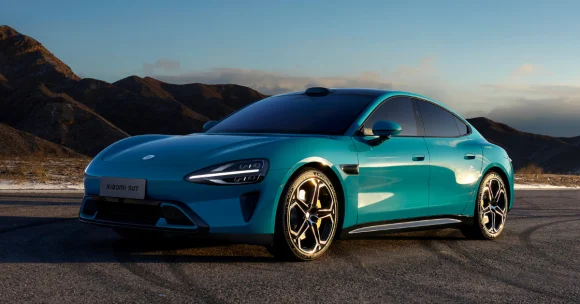Smartphone giant Xiaomi unveiled its first electric vehicle (EV), the SU7 sedan. Since the car will run on Xiaomi’s HyperOS software, it is essentially a ‘smartphone on wheels.’
The EV has been under development since March 2021, backed by 10 billion yuan (US$1.4 billion) from Xiaomi Automobile. Production began in December 2023, and the sedan will be market-ready by February 2024.
Lei Jun, founder and CEO of Xiaomi Group, quoted a sentence from Chinese poetry at the vehicle’s unveiling, “with firm strides we are crossing its summit.”
SU7: Xiaomi’s EV a technological marvel
The EV – which will be available in two versions, the SU7 and SU7 Max – is a technological marvel equipped with air suspension, adaptive dampers, an active shutter grille, and an active rear wing with four adjustment levels.
It also sets a record for EVs, reaching a maximum speed of 27,200 RPM, along with 425kW output, and 635N·m peak torque. The SU7’s HyperEngine V8s is equipped with an ultra high-strength silicon steel plate with a tensile strength of 960MPa (megapascals.)
This means the vehicle’s tensile strength – the amount of force it can withstand – is twice that of the industry standard. The maximum speed of 27,200 RPM is also faster than the average EV.
Standard electric cars operate between 2,000 to 8,000 RPM, while high-performance EVs exceed 10,000 RPM. Only some EVs are capable of reaching up to 20,000 RPM. Thus, the SU7 is an example of an EV designed for exceptionally high performance.

SU7’s features
Some of the EV’s other features include the CTB Integrated Battery Technology, which was developed by Xiaomi. The high-end model can reportedly go as far as 800 km (500 miles) on a full charge, while the base model clocks 668 km (415 miles.)
The SU7 also features a 101kWh battery pack from Chinese giant CATL, and is capable of charging for a 220 km range in just five minutes. It accelerates from zero to 100 km in under 3 seconds – 2.78 seconds to be exact.
It is also equipped with a 16.1-inch touchscreen in 3K resolution. This entertainment unit is powered by Xiaomi’s Qualcomm Snapdragon 8295 SoC (system-on-chip). Then there’s also Xiaomi Pilot, a driver-assistance program with 16 functions.

Bigger picture
Xiaomi has already invested $1.4 billion towards research and development, setting a new course for electric vehicles.
Lei says Xiaomi is investing “tenfold, starting from the development of fundamental core technologies, committing to constructing an outstanding vehicle. Through 15 to 20 years of effort, Xiaomi aims to become one of the top five global automakers.”
The EV industry evolution relies on “integrating full-stack technologies,” which is why Xiaomi is focusing on industrial manufacturing, smart software, and AI. “[The EV] will completely redefine the automotive industry, marking a significant leap in its technological landscape,” the smartphone giant says.
NOW READ: CES 2024: AI, robots, and electric cars revving up this year
About the author
Cheryl has contributed to various international publications, with a fervor for data and technology. She explores the intersection of emerging tech trends with logistics, focusing on how digital innovations are reshaping industries on a global scale. When she's not dissecting the latest developments in AI-driven innovation and digital solutions, Cheryl can be found gaming, kickboxing, or navigating the novel niches of consumer gadgetry.










